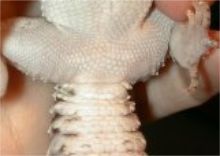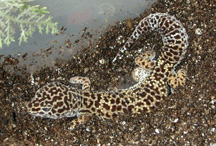|
Name: Leopard
Gecko
HistoryLeopard geckos are found in some parts of Iran, Afghanistan, Pakistan, and India. Leopard Geckos are different from many of species of geckos. They do not have lamellae on their feet which means they don?t have an exceptional ability to climb (particularly not glass). Another difference in the Leopard Gecko is that they have eyelids, which is uncommon for geckos. A male can reach a length of 11 inches with females slightly smaller growing 9-10 inches. Leopard Geckos consist of yellow and dark purple bands with black spots. Breeders have developed morphs by breeding different colored geckos and over many generations have developed high-yellow, striped, leucosticte, jungle, ghost and even albino Leopard Geckos. Selecting and SexingWhen selecting your Leopard Gecko look for signs of health. Leopard Geckos are popular making it easy to find a healthy one. Look for dried skin around the feet, if there is some present, this may be an indication of housing conditions that did not enable proper shedding of the skin. A healthy Leopard Gecko will have bright eyes, bright colorful skin, should be alert and have a nice fat tail. Even a hyper one that runs and jumps is healthy, although that is not typical of their behavior. Try to see the gecko eat and/or drink. Male Leopard Geckos are distinguished from females by the presence of large, femoral pores right before the vent (see below). These are shaped as a V above the vent and easy to see. You may see that the male has more visible and larger femoral pores than the female. While females also have these pores, they are much less pronounced. Male leopard geckos also have a distinguishable bulge just past the vent at the base of the tail where the hemipenes are stored. The male has a large powerful body with a big head, followed by a strong neck. Their tail is also bigger and shorter than the females. The female has a slim body and a smaller head and neck than the male. This is easy to see, when you have two adults side by side.
HousingWhen housing Leopard Geckos males should be kept apart from each other. Leopard Geckos like many other herps are territorial and males will suppress other male geckos until death or separation. One or maybe even two geckos, depending on the number of hiding places, can be kept in a 10-gallon tank. Otherwise one male can be housed with 3 females in any standard 20-gallon aquarium. If your intentions are for breeding a "harem" system can be utilized. This setup consists of usually one male and as many as 10 females. Multiple containers, such as a sweater box, house the females and the male is moved from one container to the next breeding with each female. If you are planning on having multiple Leopard Gecko colonies, a rack system will prove to be the most space saving and efficient setup (see picture). Hiding spots should be available in the housing containers. These can be constructed from empty containers around the house such as an empty margarine tub, Tupperware container, cardboard box or for more realistic looking effects, pet stores have different types of hiding objects. You do NOT want to use tree bark, sticks or anything of the sort from outside. These may contain parasites and contaminate your herps. Leopard geckos shed their skin on a regular basis. An enclosure with high humidity should be provided to enable proper shedding of the skin. This can be done by simply dampening a moss, peat or shredded paper to layer the high humidity hiding place. If this is not done often times the result will be the loss of digits, as the old skin clings to the reptile and may cut off circulation to their extremities. A shoebox makes a good high humidity hiding spot. Simply cut an opening and fill half of the container with the chosen materials. The substrate or flooring in your terrarium can be of several materials. Newspaper, sand, lizard litter, reptile bark, Astroturf, and peat moss are all examples of substrate that can be used. Be cautious with sand, if an over abundance is ingested by a Leopard Gecko, it could cause serious problems (be very cautious with baby geckos with sand). Beware of substrate that claim to be harmless if ingested, there are no standards or regulations on these materials. FeedingThe adults will eat adult sized crickets, large mealworms, king mealworms, and occasional pinkie mice. Adults should be fed every other day and juveniles everyday. During breeding season adults should be fed everyday. It is important to provide calcium supplements to prevent nutritional disorders. This can be done in a few different ways 1)gut loading - this is were the crickets are fed the calcium and vitamins, 2) dusting - place the insects in a plastic bag with the powder supplements, shake the bag until insects are dusted with the powder or 3) fill a dish with calcium powder and the Leopard Geckos will eat it straight from the dish. For water to drink Leopard Geckos will drink from a small dish. Water should be changed every 2-3 days. Misting the terrarium once or twice a day can also me a source of water for your geckos. HeatingLike most reptiles Leopard Geckos are cold-blooded and require a heat source to warm their bodies. For your geckos a ceramic heat emitter (CHE) can be used. A CHE is more efficient than a heating lamp and will last longer than a light bulb. Leopard Geckos being nocturnal do not require a full spectrum bulb or even any light source. An under-the-tank heating pad can also be used to heat your terrarium. One end of the terrarium should be heated to 86-88 degrees; the other end can range from 70-80 degrees. One problem with a heat lamp is that the light may affect their nocturnal instincts and that the heat must be maintained throughout the night. Maintaining a warm temperature is essential when keeping leopard geckos. Digesting food, regulating their immune systems and other problems can arise if this is not done. A heat rock is something that should be avoided if at all possible. These have been known to short out or even cook your pet because they are laying directly on the rock. Breeding
|




